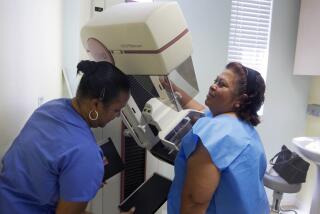More Breast-Feeding, Lesser Risk of Cancer
- Share via
Women can reduce their risk of breast cancer if they extend the duration of breast-feeding, according to a study to be published today using data from 30 countries.
It is well known that childbearing can reduce a woman’s risk for breast cancer, but this large analysis, combining research from 47 epidemiological studies from around the globe, is the first to dissect out the specific protective effect of breast-feeding over a woman’s lifetime.
The research, to be published today in the Lancet journal, predicts that if women in developed countries would extend the time they breast-feed by six months, approximately 250,000 cases of breast cancer, or 5% of the total, could be prevented each year.
The differences in patterns of breast-feeding around the world are enough to account for why breast cancer is so rare in developing countries and so common in the United States and other developed countries, said Valerie Beral, an Oxford University epidemiologist and one of the central organizers of the project.
Dr. Wendy Slusser, director of the breast-feeding research program at UCLA’s school of public health and medicine, said the study is unique--the large numbers allowed researchers to take into account any of the confounding variables that may also affect breast cancer, and therefore tease out the contribution of breast-feeding.
Previous research showed a benefit only for pre-menopausal women, whereas this study shows that breast-feeding can protect a woman throughout her lifetime, Slusser said.
“This is a minimal technological intervention to reduce risk,” Slusser said. It can be hard to change the number of children or the timing of childbearing, but it is simple to increase the duration of breast-feeding, she said.
The U.S. has one of the lowest breast-feeding rates of the countries that contributed to the study, with 50% of women breast-feeding, compared to a rate of 90% in Japan and the Scandinavian countries.
Slusser said that, in California, 80% of women breast-feed at the time of their children’s births. But after 6 months, only 40% continue the practice. They may stop because of lack of support in the workplace or from their families, Slusser said.
Dr. John Glaspy, medical director of the Oncology Clinic at UCLA’s Jonsson Comprehensive Cancer Center, supports the general findings of the study. But because the research combined data from so many different sources, he said the exact decrease in risk must be interpreted with caution.
The study looked at data from 50,302 women with cancer and 96,973 control subjects who were cancer free, from 30 countries around the world.
Researchers compared data on women from developing countries who had a breast-feeding duration of three months and an average of two or three children, to women in developing countries such as rural Asia and Africa, where women breast-feed over two years and have an average of six children.
Researchers calculated a decline in risk of 4.3% for every year of breast-feeding. That was consistent across many variables that contribute to breast cancer risk; the number of children a woman has, her weight, and age of menopause.
“We’re not saying women should run out and have six children, Oxford’s Beral said. “We need to understand how this works so we can try to mimic the effect.”
Glaspy hypothesizes that breast-feeding reduces risk of breast cancer because it reduces the number of menstrual cycles a woman has over her lifetime.
Many other factors that affect breast cancer risk also are linked to a woman’s total number of menstrual cycles--age of menarche, age of menopause, and number of children, Glaspy said. The factors decrease the lifelong exposure of a woman’s breast to estrogen surges, which occur during the first weeks of the menstrual cycle. When a woman is breast-feeding, she is less likely to ovulate and the surges of estrogen are less frequent.
Glaspy said the challenge is to fit these findings into the lifestyles of modern women. “We need to provide women with the advantages of lots of pregnancies and early menopause,” he said, “without having lots of children.”





